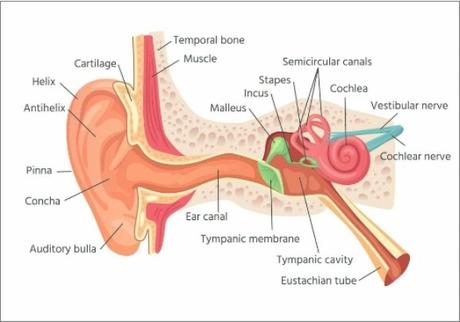The eardrum vibrations caused by sound waves move the chain of tiny bones (the ossicles – malleus, incus and stapes) in the middle ear transferring the sound vibrations into the cochlea of the inner ear.
This happens because the last of the three bones in this chain, the stapes, sits in a membrane-covered window in the bony wall which separates the middle ear from the cochlea of the inner ear. As the stapes vibrates, it makes the fluids in the cochlea move in a wave-like manner, stimulating the microscopically small ‘hair cells’. Cells near the wide end of the snail-shaped cochlea detect higher-pitched sounds such as a child crying, those closer to the center detect lower pitched sounds such as a large dog barking.
As the hair cells move up and down then microscopic projections on top of them bump against an overlying structure and bend which causes pore like channels to open up and chemicals rush into the cell creating an electrical signal.
The auditory nerve carries these signals through a complicated pathway in the brainstem before arriving at the hearing centres of the brain, the auditory cortex. This is where the streams of nerve impulses are converted into meaningful sound.

When I was a Medical Engineer one of the jobs was to check the accuracy of equipment around the hospital. We had test equipment to do this but as often as not I’d check on myself as well. So, one day back in around 2008 I was in the Audiology Department and casually put on the headphones in the sound proof room and went through the test. At first I thought the headphones were faulty but after checking again I realised that I had a small hearing loss at 8 kHz. It wasn’t a problem and it was only when this subject of vibration came up that I remembered the occasion and I’m only mentioning it now as an example of how the body can compensate for slight faults.
As a matter of interest the human hearing range of a healthy individual is between 20 Hz and 20000Hz with the higher frequencies ( or number of vibrations per second ) gradually fading during a lifetime. Human speech covers the range of 200 – 8000Hz.
What the auditory system cannot filter or compensate for, of course, is what sort of vibration is going into the ear in the first place. Personally, as far as I’m concerned, popular music stopped not so very long after Good Vibrations.
And this really did have vibrations.
Puerto Rico, Gran Canaria
Listen
to the rhythm of drills
breaking brown rocks
and space from hill
for elegant cranes
to turn in a Sun
taking huge factors
of gray lotion
smoothed over shapes
that are baking all day
that look forward to night
when the still white faces
of the apartments opposite
are made over with make up
of light and shade
and the dance of the drills
is taken by a bass
from the clubs and bars
of the red, white and blue district
and creeps through my bedroom
the high notes saved for three a.m.
the air in my room tuned to
Puerto Rico, you’re a great audience.
In the morning
listen
to the rhythm of drills.
Terry Quinn
First published in Equinox 2005
Email ThisBlogThis!Share to TwitterShare to Facebook
Reactions:
